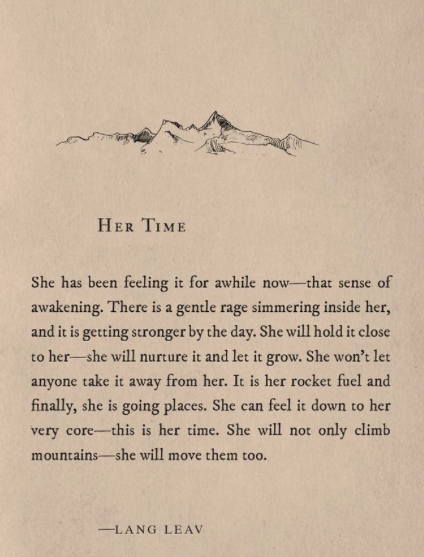I do love this passage by Lang Leav from The Universe of Us. Rage is upon us. At this moment in his-story, it might be her-time. Rage, when nurtured and directed right, is thoroughly appropriate and needed.

In This One Wild and Precious Life I refer rage as necessary for courage, which we need right now.
As kids – little girls in particular – we’re told to mute our rage should we want to fit into polite society. But here’s the thing. Anger is often a very healthy emotion toprocess rather than bottle up. Crucial, in fact. You might lovethis as much as I do: the word courage quite literally breaksdown to “rage” of the “heart” (coeur in French).A raging heart brings us the courage to do what is required.
I also tell the story of Kali, the Hindu goddess of rage. For me, it provides an insight into the timeless role of feminine rage. Far from being a dangerous thing, about-to-erupt feminine rage is a vital correcting force during periods of decadence, sloth and destruction of the planet. It commands respect. It must.
To cut a long and fun mythological story to a paragraph, once upon a time the god Shiva was being a lazy, flaccid bloke, spending all his time meditating and failing to protect Earth. So the other deities sent him the goddess Shakti (who takes the form of Kali, goddess of rage, when required) to coax him into waking the fuck up. Anyway, a bunch of things happened where some other deity dudes do the wrong thing by Shaktiand put power in the way of good, which maddens Shakti, and then Shiva tells her unhelpfully to (eek) “calm down” and then basically “forbids” her from speaking up. At which point Shakti transforms into Kali, a formidable monster-thing with fangs and a necklace of severed male heads. And she rages. Shiva gets the point quite quickly, lifts his game and re-acknowledges the importance of the feminine.
In Hindu mythology, which dates back around 5,000 years, Kali is both the fundamental feminine energy that animates the world, and the righteous rage that keeps in check the masculine forces of greed, sloth, power and control. She would erupt in the goddesses when a man underestimated or blocked the feminine or refused to show up for life. Kali destroyed to allow new life to be created. Most myths stand the test of time, in metaphor form. I find comfort in the universal truths they spell out, and, in this case, the most bodacious acknowledgment that rage – and, yes, feminine rage – is often entirely appropriate and purposeful. There’s not a woman – or man, actually – who hasn’t smiled, air-punched or nodded wildly upon hearing the Kali story.
This One Wild and Precious Life
Will just leave this here as thought-shifting utterance.

